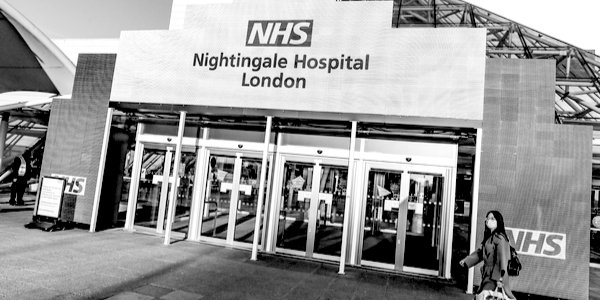ON April 13, 2020, the second-largest Nightingale Hospital in the UK opened its doors. Named the Dragon’s Heart hospital, or Ysbyty Calon Y Draig, it was located on the pitch of the Principality Stadium in Cardiff. It was the only temporary hospital in Wales to be utilised, despite £166million being spent on such Welsh hospitals and building contract deals worth £40million subsequently revealed.
Dragon’s Heart was operated by the Cardiff and Vale University health board. Its CEO at that time, Len Richards, explained that the hospital name (chosen among suggestions from the general public) was ‘inspired by the legend of the red dragon standing steadfast in the face of adversity’. He confirmed that the health board had carried out modelling and predictions of patient-number scenarios, aided by research (now infamous) from Imperial College, London.
The project involved 5,000 planning hours, 650 contractors, 30 members of the armed forces and £8million in capital spending from the Welsh government.
The mainstream media naturally had a field day reporting on the field hospitals. The Dragon’s Heart opened with 300 beds, with space to expand, yet the BBC headline on March 27 was ‘Principality Stadium to be used as 2,000-bed hospital’.
Wales Online – often dubbed Tales Online on X – reported on the two ‘massive oxygen tanks’ installed by crane outside the stadium and stated that the hospital would ‘see 18,000 meals being provided every day, as well as an equal number of bedpans needing emptying and three and a half tonnes of clinical waste needing to be disposed of every day’.
The Daily Mail reported how Prince Charles had opened the hospital via videolink after ‘beating Covid-19’. Health Minister Vaughan Gething crowed: ‘By ramping up the number of beds available in settings such as this, we can make sure there is capacity in our hospitals to care for those most in need during these extraordinary times.’
To add to the wartime-ethos melodrama, we also learned from the BBC of the ‘plane-crash hero’ and former bomb disposal expert (who previously pulled three people from a burning plane) working at the Dragon’s Heart, running the portering team.
According to its Wikipedia page, the primary focus for this hospital was ‘on patients coming to the end of their illness and those recovering to return home, allowing more capacity to become available within intensive care wards elsewhere for critical patients’. The page claims also that there would be patients on palliative care plans located at the site. Indeed, this is what I was told over the phone when my aunt – who had been admitted to hospital after a fall in April 2020 – was transferred to the Dragon’s Heart for rehabilitation the following month. My aunt had ‘tested positive’ upon admission to Llandough hospital (despite having been housebound and alone for 13 days). She was then shoved into a covid ward and given a Do Not Attempt Resuscitation instruction and an end-of-life care pathway in her list of anticipatory medications. Notably, her hospital notes included the written clinical observation: ‘Covid 19 onset? Consistent with bacterial pneumonia’ – demonstrating that medical staff didn’t know for sure what to diagnose.
The hospital was open for less than eight weeks and my then 88-year-old aunt was discharged around one week before it was closed down completely on June 4. She told me that a 99-year-old woman was discharged at the same time and came home saying: ‘I think they’re exaggerating it (the pandemic)’. She told me how, on fine sunny days, some patients would be taken in wheelchairs outside into the sunshine and that she passed ‘hundreds of empty beds’. Of course, these good news stories of old dears ‘beating the virus’ and returning home completely evaded press attention.
This week I have received a response to a freedom of information request put in to Cardiff & Vale health board. I requested to know how many of the patients were admitted for rehabilitation and subsequently discharged. I also asked how many patients went to the Dragon Heart for palliative care and subsequently died. Finally, I asked the ages of all patients that were discharged.
In response to my first two questions I was curiously informed that ‘No beds / wards there were set up for specific streams of rehabilitation or palliative care’, which contradicts mainstream articles and Wikipedia.
In response to my final question I received a table of two columns, one headed ‘age of patient’, the other column containing the numbers – of that age – discharged. I quickly verified that there was an 88-year-old on the list (actually there were two) and a 99-year-old – indeed there was. Good old sharp-witted auntie!
The youngest patient discharged was 43. In fact, there were two patients admitted and discharged in their forties, one aged 57 and three patients in their sixties. According to the table there were actually 47 patients in total, ALL of whom were discharged – so zero deaths at this hospital.
The rest of the Dragon’s Heart patients were all 71 and over – seven in their seventies, ten in their eighties and six nonagenarians. My online percentage calculator tells me that 87.23 per cent of the patients in this nightingale hospital were over 70 – the original demographic that we were told would be at risk from the virus. Those aged 80 and over made up 65 per cent – two-thirds – of the total patients sent there.
Essentially, the Dragon’s Heart turned out to be no more than an extremely costly rehabilitation unit. Perhaps the Damp Squib might have been a more fitting name?











